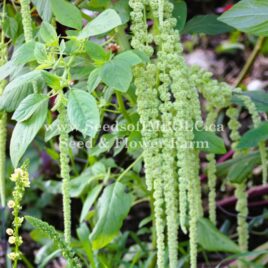Description
These curious propeller-like flowers produce stubby white tubular petals which surround the yellow disc on this unique and unusual form which produce a shimmering effect when wind moves them. The name derives from Malmesbury in Wiltshire where it was found by Martin Cragg-Barber of the Natural Selection nursery. Matricaria, also known as feverfew, botanical name Tanacetum parthenium, is very cheerful, prolific branching flower, excellent as a filler in bouquets! Reminds me of little cogwheels and is a stunning bouquet filler!
Feverfew is believed to aid digestion, and lower blood pressure. There is some scientific evidence that drinking feverfew tea, or adding a few fresh leaves leaves to a sandwich everyday, can for some people, reduce the frequency and severity of migraine headaches.
Bees (and many other insects) hate feverfew and will avoid an area where it is planted. Can help repel damaging insects when placed with roses or other ornamentals. Compact and spreading growth to 3 ft. tall, topped with small, yellow-centered, white daisy-like flowers.
Transplant (recommended) – Sow 5-10 weeks before transplanting in either spring or fall. Transplant 3-4 weeks before first frost in fall. Gently press the seeds into growing medium, but do not cover as light aids germination. Bottom water or mist to avoid covering the seed with displaced soil. Transplant to cell packs or 3-4″ pots 2-4 weeks after sowing. Harden off before transplanting. Kept at 65-70°F. (21°C), germination averages 10- 20 days.
Direct seed – As soon as soil can be worked. Gently press the seeds into the soil, but do not cover as light aids germination. Keep soil surface moist until germination. Thin when seedlings have the first true leaves. Thin seedlings to 9-12″ apart.
I sow most seeds in an unheated greenhouse and wait for natural germination, as many seeds have built-in dormancy mechanisms, often waiting for natural spring germination, hence giving them a full season of growth.
Flower farmers: To achieve longer stems and earlier blooms, fall planting recommend- outdoors or in high tunnels. By overwintering young plants inside a high tunnel for spring harvest, you can attain very tall (up to 48″) and abundant stems. Spring Planting: For optimal stem and flower quality, treat spring-planted feverfew as an annual. Row covers can also be used to protect early plantings during cold spells.
A long-day plant, meaning flowering is generally initiated during the longest days of the season. Plants will eventually bloom under short-day conditions but on shorter stems.
Harvest when nearly all of the flowers in a spray are open, otherwise they will wilt. Feverfew is considered a dirty flower, turning vase water dark and murky overnight even when floral preservative is used. A few drops of bleach can be added to the water to combat this trait. Expect a vase life of 7 days if preservative is used.
Light, well-drained, moist, fertile soil. 6.0-7.2 pH preferred. Excellent cut and dried flower. Beds, borders, and containers.
Height: 28-36”, full sun, Days to maturity: 100-110 days, Pinch: not necessary, Tender or short-lived perennial in Zones 5–9, Open Pollinated
Approx seeds per packet: 150






Reviews
There are no reviews yet.